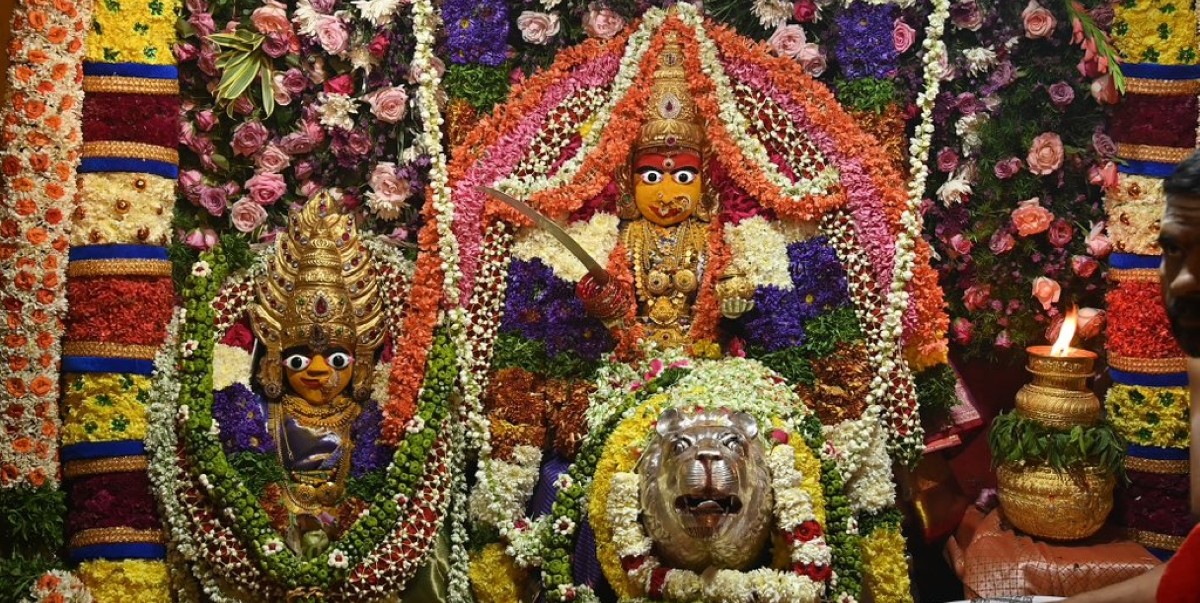Legend has it that Bonalu got its start when a deadly plague swept through the twin cities of Hyderabad and Secunderabad in 19th century.
Published Jul 15, 2025 | 3:08 PM ⚊ Updated Jul 15, 2025 | 3:08 PM

Ujjaini Mahankali Bonalu at Secunderabad. (Revanth Reddy/ X)
Synopsis: Bonalu, one of Telangana’s most lively festival, is an annual offering to goddess. The festival is traditionally held during the Hindu month of Ashadam and lasts four weekends. Different parts of Hyderabad and Secunderabad host the festivities on different Sundays, with the celebrations at the Ujjaini Mahankali Temple, also known as Lashkar Bonalu, considered one of the most prominent and symbolic.
Before the first light of dawn could touch the skies of Secunderabad, on Sunday, 13 July, the streets around Ujjaini Mahankali Temple had already come alive with colour, chants, and the unmistakable rhythm of devotion. It was 4 AM, but for thousands of women carrying decorated bonam pots on their heads, the day already begun.
Bonalu, one of Telangana’s most lively festival, is an annual offering to goddess. The name is derived from the Telugu word “Bhojanalu”, which means “meal”—an offering of rice, jaggery, and curd, presented in elaborately ornamented metal or earthen pots decorated with neem leaves.
The women bring these sacrifices to honour their vows, show gratitude for the goddess’ protection, and ask for her blessings on behalf of their families.
Later in the day, Chief Minister Revanth Reddy and Minister Konda Surekha also arrived at the temple, where the spirit of Bonalu was already in full bloom. As they stepped inside, they offered silk garments to the goddess and took part in the rituals.
The festival is traditionally held during the Hindu month of Ashadam and lasts four weekends. Different parts of Hyderabad and Secunderabad host the festivities on different Sundays, with the celebrations at the Ujjaini Mahankali Temple, also known as Lashkar Bonalu, considered one of the most prominent and symbolic.
The month-long festivities begin on the first Sunday at the Jagadamba Temple in Golconda Fort. On the second Sunday, celebrations shift to the Ujjaini Mahakali Temple in Secunderabad and the Balkampet Yellamma Temple. The third Sunday is marked by rituals at the Pochamma and Katta Maisamma temples in Chilkalguda, and the Matheswari Temple in the Old City. The fourth and final Sunday concludes the celebrations with offerings at the Golconda Temple once again.
For the onlookers, the colourful attire was the first thing that caught the eyes. Women wore embroidered blouses that gleamed in the sunlight. Their hair was nicely done and adorned with malle poovulu (jasmine flowers). On the other hand, young girls wrapped half sarees or lehenga cholis.
Numerous processions marched through Secunderabad’s streets throughout the day, led by Pothurajus – men adorned with turmeric and vermillion, considered as the goddess’s brother and protector of the procession.
The ground vibrated with the beat of drums, their deep thumps rattling through the soles of your feet. Bhajans played softly in the background. Women balanced bonam pots, their movements slow and graceful. The air was warm and fragrant—a mix of turmeric, neem leaves, and sandalwood incense, wrapping the entire street in a calm, sacred hush.
The festival has a long history. Legend has it that Bonalu got its start when a deadly plague swept through the twin cities of Hyderabad and Secunderabad in 19th century.
According to the Government of Telangana website, it is believed that, a military battalion from Hyderabad, stationed in Ujjain at the time, prayed to the Mother Goddess Mahankali at a temple there. They vowed to install her idol in Secunderabad and offer a special meal—bonam—if the plague ended and their people were spared.
They went back to Hyderabad and kept their promise after the disease had passed.
Year after year, followers have kept the promise alive by bringing bonam pots as a sign of gratefulness and a request for continuing protection.
(Edited by Sumavarsha)
